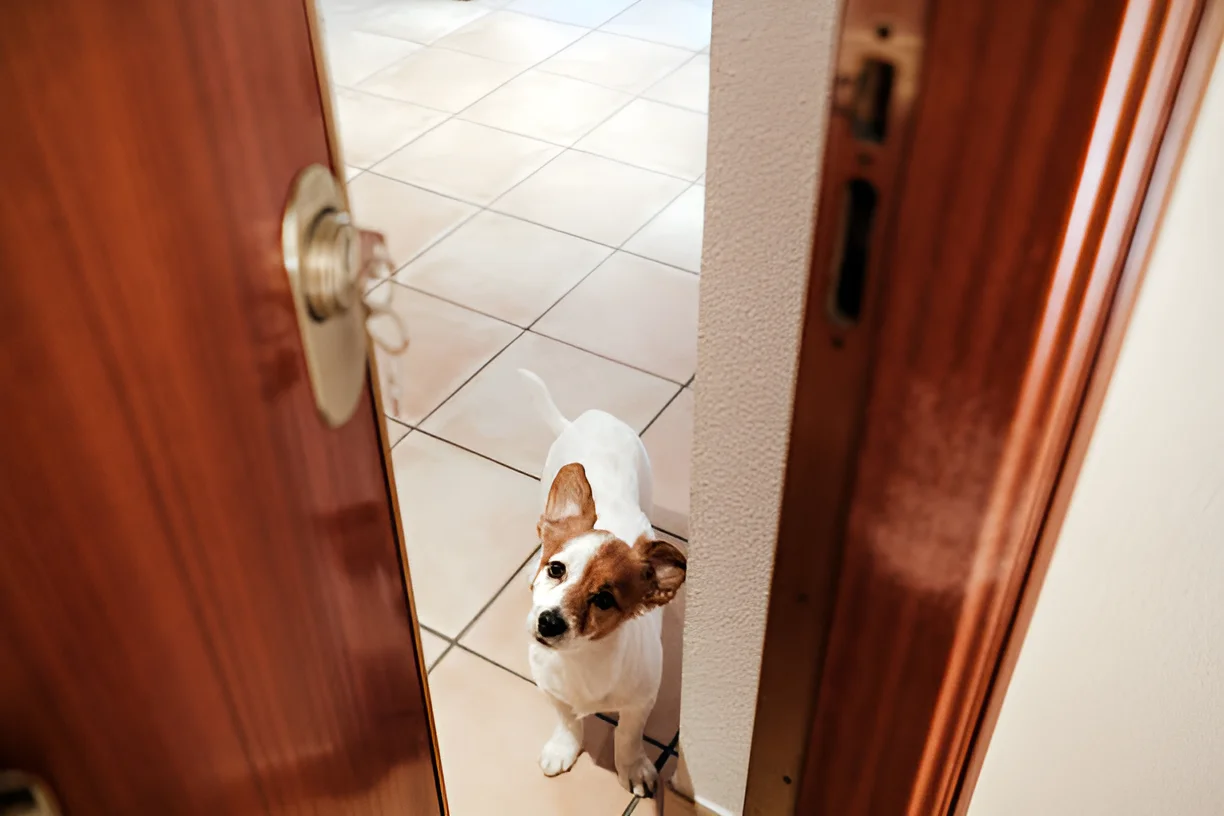Yes, dogs are smart enough to open doors! With the right combination of observation, training, and problem-solving skills, many dogs can learn to manipulate door handles and push doors open.
Dogs are known for their intelligence and ability to learn new tricks and commands. But can they really figure out how to open doors? The answer is a resounding yes! Many dogs have demonstrated the ability to open doors, whether by using their paws, noses, or even their mouths. This article delves into the fascinating world of canine intelligence, exploring how and why dogs can open doors, and what this says about their cognitive abilities.
Understanding Canine Intelligence
To understand how dogs can open doors, it’s essential to first grasp the basics of canine intelligence. Dogs are highly observant animals, capable of learning through imitation and repetition. Their intelligence can be categorized into three main types:
- Instinctive Intelligence: This refers to the innate abilities that dogs are born with, such as herding, hunting, or guarding.
- Adaptive Intelligence: This is the ability of a dog to solve problems on its own, such as figuring out how to open a door.
- Working and Obedience Intelligence: This type of intelligence is measured by how well a dog can learn commands and tasks from humans.
How Dogs Learn to Open Doors
Dogs learn to open doors primarily through observation and trial and error. Here are some common methods they use:
- Observation: Dogs watch their owners open doors and mimic their actions. They notice that turning a handle or pushing a door results in it opening.
- Trial and Error: Some dogs experiment with different ways to open doors, using their paws, noses, or mouths until they find a method that works.
- Training: With proper training, dogs can be taught to open doors on command. This involves rewarding the dog for successfully opening the door, reinforcing the behavior.
The Role of Breed and Size
Not all dogs are equally adept at opening doors. Factors such as breed, size, and physical strength play a significant role. For example:
- Larger Breeds: Dogs like Golden Retrievers, German Shepherds, and Labradors are more likely to open doors due to their size and strength.
- Smaller Breeds: While smaller dogs may struggle with heavy doors, they can still learn to open lighter doors or those with lever handles.
Training Your Dog to Open Doors
If you’re interested in teaching your dog to open doors, here are some steps you can follow:
- Start with a Lever Handle: Lever handles are easier for dogs to manipulate than round knobs.
- Use Positive Reinforcement: Reward your dog with treats or praise whenever they successfully open the door.
- Practice Consistently: Regular practice helps reinforce the behavior. Start with simple doors and gradually increase the difficulty.
- Be Patient: Training takes time, and each dog learns at its own pace. Be patient and consistent with your training.
Potential Issues and Solutions
While teaching your dog to open doors can be impressive, it can also lead to some challenges:
- Safety Concerns: Dogs that can open doors might access areas that are unsafe, such as kitchens or garages. Consider using childproof locks or gates to restrict access.
- Escaping: Some dogs may use their door-opening skills to escape from the house or yard. Ensure your home is secure and supervise your dog when necessary.
Real-Life Examples of Door-Opening Dogs
There are numerous stories of dogs who have mastered the art of opening doors. For instance, a Labrador named Max became famous for his ability to open the front door and let himself out for a walk. His owner discovered this talent when Max was caught on a security camera using his nose to push down the lever handle and then nudging the door open with his head.
Another example is a Border Collie named Bella, who learned to open the back door to let herself and her canine siblings out into the yard. Bella’s owner trained her using positive reinforcement, rewarding her with treats each time she successfully opened the door.
The Science Behind Canine Problem-Solving
The ability of dogs to open doors is a testament to their problem-solving skills. Studies have shown that dogs possess a level of cognitive flexibility that allows them to adapt their behavior to new situations. This means they can learn from their experiences and apply that knowledge to solve new problems.
One study conducted by researchers at the University of Veterinary Medicine in Vienna found that dogs are capable of understanding cause-and-effect relationships. In the study, dogs were presented with a series of tasks that required them to manipulate objects to receive a reward. The results showed that dogs could learn to use tools and solve complex problems, demonstrating their advanced cognitive abilities.
The Importance of Mental Stimulation for Dogs
Teaching your dog to open doors is not just a fun party trick; it also provides valuable mental stimulation. Dogs, like humans, need mental challenges to stay sharp and engaged. Providing your dog with opportunities to solve problems and learn new skills can help prevent boredom and reduce behavioral issues.
Here are some ways to keep your dog mentally stimulated:
- Puzzle Toys: These toys require your dog to figure out how to access a treat or toy hidden inside.
- Training Sessions: Regular training sessions can help reinforce commands and teach new tricks.
- Interactive Games: Games like hide-and-seek or fetch can provide both physical and mental exercise.
- Socialization: Allowing your dog to interact with other dogs and people can provide new experiences and challenges.
Conclusion
Dogs are undoubtedly intelligent creatures, capable of learning a wide range of skills, including opening doors. This ability showcases their problem-solving skills, adaptability, and keen observation. Whether through training or natural curiosity, many dogs can master the art of door opening, proving once again that they are truly man’s best friend.
The photo featured below the post headline is Credit: Eva Blanco/istockphoto
I hope you find this post helpful and informative. If Yes’ feel free to share it with your friends!
Frequently Asked Questions
Can all dogs learn to open doors?
While many dogs can learn to open doors, it depends on factors such as breed, size, and individual intelligence. Larger breeds with more strength are generally more successful.
Is it safe to teach my dog to open doors?
It can be safe if you take precautions. Ensure that your dog cannot access dangerous areas and consider using childproof locks to restrict access.
How long does it take to train a dog to open doors?
The training duration varies depending on the dog. Some may learn quickly within a few weeks, while others may take longer. Consistent practice and positive reinforcement are key.
What if my dog opens doors and escapes?
Ensure your home is secure and supervise your dog. You can also use gates or locks to prevent your dog from accessing certain areas.

